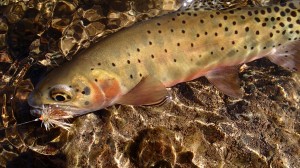Saturday, August 23, 2014 We are calling for a maximum of 20 hearty CCTU volunteers to join forces with the Coalition for the Upper South Platte and the city of Alma to complete the Hidden Treasure Mine, aka. Orange Fence Mine Decommissioning and Rehabilitating Project. By closing access and rehabbing the site, this work will both help to preserve the historical aspects of the area, populations of rare plants recently discovered at the site as well as to improve water quality of Buckskin Creek and ultimately the important fishery of the Middle Fork of the South Platte River.
Where and When: We plan to meet on Saturday, August 23rd at 9:00 AM at the Alma Town Hall located at 59 Buckskin Street, Alma, CO 80420. There is a lot of work to do so we are planning on working till 2:00PM.
Lunch! A BBQ Lunch will be provided by a generous supporter for all volunteers.
Project Description: Work will include rehabilitating the abandoned mine site on USFS property 4 miles outside of Alma on County road 8.. The site has significant erosion issues exacerbated by illegal digging with heavy equipment. Runoff flows over tailings and goes subterranean before entering Buckskin Creek, which then drains into the Middle Fork of the Upper South Platte. Part of the project entails creating a diversion to curtail water moving over the tailings. The illegal use activity also created access point for off road vehicles, multiplying the damage. Work will minimize the issues through decommissioning the site, re-seeding with native perennials, transplanting trees and shrubs. This work will reduce degradation of this ‘attractive nuisance’ and enhance regeneration at this polluted site, improving downstream water quality. The Town of Alma will donate heavy equipment and staff for the project, CUSP will donate staff and seed, and a generous supporter will provide a BBQ lunch. This project will be completed through genuine dedication of key local community members and committed efforts of CCTU volunteers. Please plan to join us on this collaborative and impact-full effort.
Important Notes:
CUSP will provide materials and necessary tools to complete project work.
Events may be canceled or rescheduled due to bad weather, which could create hazardous conditions for volunteers and staff. Staff will monitor weather and notify you of any changes in a timely fashion.
Please Bring:
Any applicable medicines (including epi-pen and inhalers, if needed)
Sun block and sun glasses (or safety glasses)
Layered clothing appropriate for outdoor work
Waterproof work boots
Work Gloves
A container for water, the use of reusable containers is encouraged, refills will be provided
Please Call Jim Klug at 303-565-7504 to sign up and to arrange for car-pooling.











